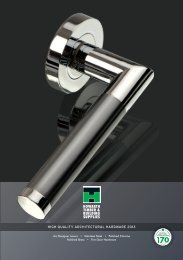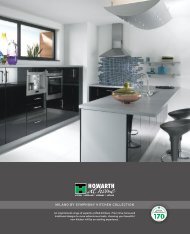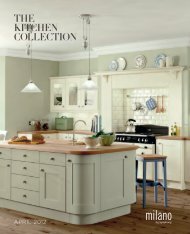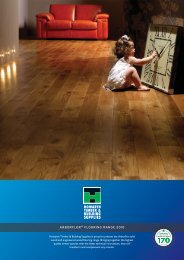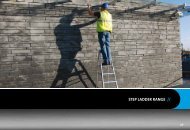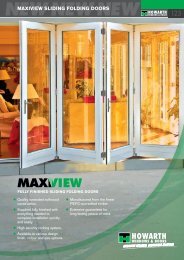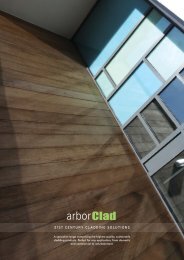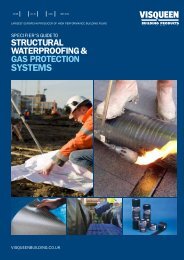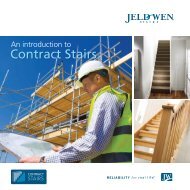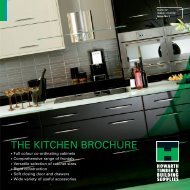A customer's guide to The Code for Sustainable ... - Howarth Timber
A customer's guide to The Code for Sustainable ... - Howarth Timber
A customer's guide to The Code for Sustainable ... - Howarth Timber
Create successful ePaper yourself
Turn your PDF publications into a flip-book with our unique Google optimized e-Paper software.
What is the <strong>Code</strong> <strong>for</strong> <strong>Sustainable</strong> Homes?<br />
<strong>The</strong> <strong>Code</strong> <strong>for</strong> <strong>Sustainable</strong> Homes sets a single national standard within which the home-building<br />
industry can design and construct homes <strong>to</strong> higher environmental standards. <strong>The</strong> <strong>Code</strong> replaces<br />
the EcoHomes schedule and is being managed by BRE Global (Building Research Establishment).<br />
<strong>The</strong> code is an environmental assessment rating method <strong>for</strong> new homes.<br />
It assesses environmental per<strong>for</strong>mance in a two stage process (design stage and<br />
post-construction stage) using objective criteria across sustainable design categories.<br />
<strong>The</strong> design categories included within the <strong>Code</strong> are:<br />
• Energy and CO 2<br />
Emissions • Pollution<br />
• Water<br />
• Health and Well-being<br />
• Materials<br />
• Management<br />
• Surface Water Run Off<br />
• Ecology<br />
• Waste<br />
<strong>The</strong> latest version of the <strong>Code</strong> – November 2010 - includes new sections <strong>for</strong> building<br />
fabric efficiency, energy display devices and surface water run-off requirements.<br />
All new developments required <strong>to</strong> meet a code assessment rating<br />
will now be assessed under this <strong>Code</strong> version<br />
Each category is assessed against a set of per<strong>for</strong>mance criteria (see Table 1.1), <strong>for</strong><br />
which credits are awarded and an overall sustainability score calculated. <strong>The</strong> results<br />
of the <strong>Code</strong> assessment are recorded and a certificate assigned <strong>to</strong> each dwelling.<br />
Table 1.1: Summary of Environmental Categories and Issues<br />
Categories<br />
Issue<br />
Energy and CO 2<br />
emissions<br />
Water<br />
Materials<br />
Surface Water Run-off<br />
Waste<br />
Pollution<br />
Health and Well-being<br />
Management<br />
Ecology<br />
(M) denotes issues with manda<strong>to</strong>ry elements.<br />
Dwelling emission rate (M)<br />
Fabric energy efficiency (M)<br />
Energy display devices<br />
Drying space<br />
Energy labelled white goods<br />
External lighting<br />
Low or zero carbon (LZC) technologies<br />
Cycle s<strong>to</strong>rage<br />
Home office<br />
Indoor water use (M)<br />
External water use<br />
Environmental impact of materials (M)<br />
Responsible sourcing of materials – basic building elements<br />
Responsible sourcing of materials – finishing elements<br />
Management of Surface Water Runoff from developments (M)<br />
Flood risk<br />
S<strong>to</strong>rage of non-recyclable waste and recyclable household waste (M)<br />
Construction site waste management<br />
Composting<br />
Global warming potential (GWP) of insulants<br />
NO X<br />
emissions<br />
Daylighting<br />
Sound insulation<br />
Private space<br />
Lifetime homes (M)<br />
Home user <strong>guide</strong><br />
Considerate Construc<strong>to</strong>rs Scheme<br />
Construction site impacts<br />
Security<br />
Ecological value of site<br />
Ecological enhancement<br />
Protection of ecological features<br />
Change in ecological value of site<br />
Building footprint<br />
3



